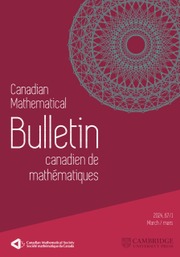Article contents
Some Normal Numbers Generated by Arithmetic Functions
Published online by Cambridge University Press:
Abstract
Let  $g\geqslant 2$. A real number is said to be
$g\geqslant 2$. A real number is said to be  $g$-normal if its base
$g$-normal if its base  $g$ expansion contains every finite sequence of digits with the expected limiting frequency. Let
$g$ expansion contains every finite sequence of digits with the expected limiting frequency. Let  $\unicode[STIX]{x1D711}$ denote Euler’s totient function, let
$\unicode[STIX]{x1D711}$ denote Euler’s totient function, let  $\unicode[STIX]{x1D70E}$ be the sum-of-divisors function, and let
$\unicode[STIX]{x1D70E}$ be the sum-of-divisors function, and let  $\unicode[STIX]{x1D706}$ be Carmichael’s lambda-function. We show that if
$\unicode[STIX]{x1D706}$ be Carmichael’s lambda-function. We show that if  $f$ is any function formed by composing
$f$ is any function formed by composing  $\unicode[STIX]{x1D711}$,
$\unicode[STIX]{x1D711}$,  $\unicode[STIX]{x1D70E}$, or
$\unicode[STIX]{x1D70E}$, or  $\unicode[STIX]{x1D706}$, then the number
$\unicode[STIX]{x1D706}$, then the number  $$\begin{eqnarray}0.f(1)f(2)f(3)\cdots\end{eqnarray}$$
$$\begin{eqnarray}0.f(1)f(2)f(3)\cdots\end{eqnarray}$$ $g$ digits of successive
$g$ digits of successive  $f$-values is
$f$-values is  $g$-normal. We also prove the same result if the inputs
$g$-normal. We also prove the same result if the inputs  $1,2,3,\ldots$ are replaced with the primes
$1,2,3,\ldots$ are replaced with the primes  $2,3,5,\ldots$. The proof is an adaptation of a method introduced by Copeland and Erdős in 1946 to prove the 10-normality of
$2,3,5,\ldots$. The proof is an adaptation of a method introduced by Copeland and Erdős in 1946 to prove the 10-normality of  $0.235711131719\cdots \,$.
$0.235711131719\cdots \,$.
Keywords
MSC classification
Information
- Type
- Article
- Information
- Copyright
- © Canadian Mathematical Society 2014
- 4
- Cited by

